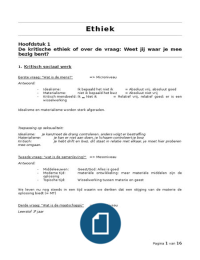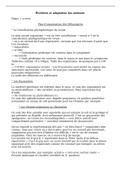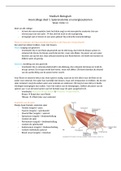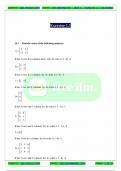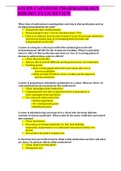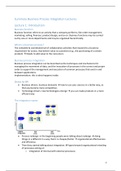Summary Mass Spectrometry
General:
Mass spectrometry: analytical chemistry method that can identify the amount and type of
chemicals present in a sample by measuring the m/z value and relative abundance of ions
Mass of compound can refer to:
- Mass number: sum of the numbers of nucleons (protons + neutrons) of elements
- Nominal mass: sum of the integer masses of most abundant isotope of each element
- Accurate mass: experimentally determined mass that allows the elemental
composition to be determined
- Exact mass: calculated mass of ion or molecule with specified isotopic composition
- H2O = 1.0078 + 1.0078 + 15.9949 = 18.0105 Da
- 1 amu = 1 Da = 1.66053904 x 10-27 kg
- H2O.+ = 18.0105 – 0.0005 = 18.0100 Da (mass electron = 0.000548579909 amu)
General:
- Not a chiral method; enantiomers give same mass spectra
- Information about primary structure, sometimes about secondary, tertiary and
quaternary structure
- Inlet system → ion source → analyzer → detection
- Mass spectrum: highly dependent on ionization method and experimental conditions
for ion formation
- Mass analyzer: sub-system that separates masses
- Single analyzer instruments: TOF, quadrupole and ion trap → mainly used when
don’t need high end MS performance → routine, know what you are looking for,
simple samples
- Hybrid instruments: contain multiple mass analyzers
Ion source (molecules converted to gas-phase ions) → mass analyzer (ion are separated
according to m/z) → detector (ion abundance for each m/z is measured)
Performance of MS:
- Mass range: max m/z
- Mass resolution: ability to separate ions with small differences in m/z values
- Resolution: R = (m/z) / (m/z) Measured at 10%
- FWHM (m/z at half height)
- Low res: Q, IT high: TOF ultra high: FT-ICR, orbitrap
- Mass accuracy: accuracy of m/z value
- Ion transmission: peak height; ratio number of ions reaching the detector and
number of ions entering analyzer
- Dynamic range: ratio of most intense and weakest signal measured (single spectrum)
Mass accuracy:
- Difference between measured mass and true (exact) mass → small as possible
- (mtrue – mmeasured) / mmeasured (most in ppm)
- Accuracy < 5 ppm required for publication of chemical compounds
,Example:
- C2H5+ = 29.03915 N2H+ = 29.01403 → m/z = 0.02512
- Resolution: R = 29/0.02512 = 1154
Magnetic and electric fields:
- Required to separate ions in gas phase according to m/z
Ionization sources:
- Hard: fragment ions so much, that there may be no molecular ion, but it gives
structural information (EI)
- Medium: molecular ion is abundant, but does not work well for larger molecules,
such as peptides and proteins (CI)
- Soft: does not fragment molecules: abundant [M+H]+ or [M-H]- → used for
biomolecules, such as peptides and proteins (ESI, MALDI)
Advantages of LC coupling to MS for:
- Small molecules (< 1 kDa):
- Reducing sample complexity
- Reducing matrix effects
- Proteins of different sizes (denaturing):
- Separation prior MS allows to distinguish and measure intact proteins in mixtures
- Synthetic polymers:
- SEC can separate polymers to give better MS results
- Heterogeneous proteins:
- LC separation reduce MS complexity and facilitate assignment
Mobile phases and additives:
- Buffers and pH modifiers should be preferentially volatile
- Recommended additives: formic acid, acetic acid, ammonia, ammonium formate,
ammonium acetate, ammonium carbonate, triethylamine
- Buffer concentration as low as possible (10-20 mM)
- Salts (e.g. ammonium formate/acetate) favor formation of adducts
- ESI: acidic mobile phases favor positive mode ionization (formic acid, acetic acid,
TFA); basic mobile phases favor negative mode ionization (ammonium hydroxide,
triethylamine, triethylamine, piperidine, ammonium bicarbonate)
- TFA: ion-pairing in HILIC with amide stationary phases → reduces retention; enables
separation intact glycoforms on basis of sugar composition → higher
chromatographic selectivity; lower MS sensitivity → best avoided or present in low
concentration → post-column dilution with other solvent (e.g. acetic/propionic acid)
Electron Ionization (EI):
M + e- → M.+ + 2e-
- Easy to apply
- Volatile and thermal stable compounds (mass < 1000 Da)
- Mass spectra peaks corresponding to molecular ion and fragment ions
- Ionization efficiency 1 ion per 103-104 molecules
- Reproducible mass spectra
, - Ekin(e) = 70 eV (electron energy that results in highest ion current)
- Ionization energies of molecules 10 eV → rest of energy deposits in the ionized
molecule during ionization
EI: reproducible, high ionization efficiency, ionization non-selective, fragmentation, other
ions formed compared to other methods, sample must be volatile and thermally stable, low
MM (<1000), energetic method, sometimes absence of molecular ion
→ radical cation is formed (M.+)
- EI: radical cation → odd number of electrons; molecular ion of fragment ion
Homolytic bond cleavages:
- Amines, alcohols, thiols:
- Formation of onium ions:
- Ketones and aldehydes:
- Alkyl benzenes:
Heterolytic bond cleavages:
- Cleavage of bond to heteroatom with formation of cation and stable atom or radical:
Secondary dissociation reactions:
- Reactions of ions formed by fragmentation
- Mainly loss of small molecules, such as H2, CH4, C2H2, CO and alkenes
General:
Mass spectrometry: analytical chemistry method that can identify the amount and type of
chemicals present in a sample by measuring the m/z value and relative abundance of ions
Mass of compound can refer to:
- Mass number: sum of the numbers of nucleons (protons + neutrons) of elements
- Nominal mass: sum of the integer masses of most abundant isotope of each element
- Accurate mass: experimentally determined mass that allows the elemental
composition to be determined
- Exact mass: calculated mass of ion or molecule with specified isotopic composition
- H2O = 1.0078 + 1.0078 + 15.9949 = 18.0105 Da
- 1 amu = 1 Da = 1.66053904 x 10-27 kg
- H2O.+ = 18.0105 – 0.0005 = 18.0100 Da (mass electron = 0.000548579909 amu)
General:
- Not a chiral method; enantiomers give same mass spectra
- Information about primary structure, sometimes about secondary, tertiary and
quaternary structure
- Inlet system → ion source → analyzer → detection
- Mass spectrum: highly dependent on ionization method and experimental conditions
for ion formation
- Mass analyzer: sub-system that separates masses
- Single analyzer instruments: TOF, quadrupole and ion trap → mainly used when
don’t need high end MS performance → routine, know what you are looking for,
simple samples
- Hybrid instruments: contain multiple mass analyzers
Ion source (molecules converted to gas-phase ions) → mass analyzer (ion are separated
according to m/z) → detector (ion abundance for each m/z is measured)
Performance of MS:
- Mass range: max m/z
- Mass resolution: ability to separate ions with small differences in m/z values
- Resolution: R = (m/z) / (m/z) Measured at 10%
- FWHM (m/z at half height)
- Low res: Q, IT high: TOF ultra high: FT-ICR, orbitrap
- Mass accuracy: accuracy of m/z value
- Ion transmission: peak height; ratio number of ions reaching the detector and
number of ions entering analyzer
- Dynamic range: ratio of most intense and weakest signal measured (single spectrum)
Mass accuracy:
- Difference between measured mass and true (exact) mass → small as possible
- (mtrue – mmeasured) / mmeasured (most in ppm)
- Accuracy < 5 ppm required for publication of chemical compounds
,Example:
- C2H5+ = 29.03915 N2H+ = 29.01403 → m/z = 0.02512
- Resolution: R = 29/0.02512 = 1154
Magnetic and electric fields:
- Required to separate ions in gas phase according to m/z
Ionization sources:
- Hard: fragment ions so much, that there may be no molecular ion, but it gives
structural information (EI)
- Medium: molecular ion is abundant, but does not work well for larger molecules,
such as peptides and proteins (CI)
- Soft: does not fragment molecules: abundant [M+H]+ or [M-H]- → used for
biomolecules, such as peptides and proteins (ESI, MALDI)
Advantages of LC coupling to MS for:
- Small molecules (< 1 kDa):
- Reducing sample complexity
- Reducing matrix effects
- Proteins of different sizes (denaturing):
- Separation prior MS allows to distinguish and measure intact proteins in mixtures
- Synthetic polymers:
- SEC can separate polymers to give better MS results
- Heterogeneous proteins:
- LC separation reduce MS complexity and facilitate assignment
Mobile phases and additives:
- Buffers and pH modifiers should be preferentially volatile
- Recommended additives: formic acid, acetic acid, ammonia, ammonium formate,
ammonium acetate, ammonium carbonate, triethylamine
- Buffer concentration as low as possible (10-20 mM)
- Salts (e.g. ammonium formate/acetate) favor formation of adducts
- ESI: acidic mobile phases favor positive mode ionization (formic acid, acetic acid,
TFA); basic mobile phases favor negative mode ionization (ammonium hydroxide,
triethylamine, triethylamine, piperidine, ammonium bicarbonate)
- TFA: ion-pairing in HILIC with amide stationary phases → reduces retention; enables
separation intact glycoforms on basis of sugar composition → higher
chromatographic selectivity; lower MS sensitivity → best avoided or present in low
concentration → post-column dilution with other solvent (e.g. acetic/propionic acid)
Electron Ionization (EI):
M + e- → M.+ + 2e-
- Easy to apply
- Volatile and thermal stable compounds (mass < 1000 Da)
- Mass spectra peaks corresponding to molecular ion and fragment ions
- Ionization efficiency 1 ion per 103-104 molecules
- Reproducible mass spectra
, - Ekin(e) = 70 eV (electron energy that results in highest ion current)
- Ionization energies of molecules 10 eV → rest of energy deposits in the ionized
molecule during ionization
EI: reproducible, high ionization efficiency, ionization non-selective, fragmentation, other
ions formed compared to other methods, sample must be volatile and thermally stable, low
MM (<1000), energetic method, sometimes absence of molecular ion
→ radical cation is formed (M.+)
- EI: radical cation → odd number of electrons; molecular ion of fragment ion
Homolytic bond cleavages:
- Amines, alcohols, thiols:
- Formation of onium ions:
- Ketones and aldehydes:
- Alkyl benzenes:
Heterolytic bond cleavages:
- Cleavage of bond to heteroatom with formation of cation and stable atom or radical:
Secondary dissociation reactions:
- Reactions of ions formed by fragmentation
- Mainly loss of small molecules, such as H2, CH4, C2H2, CO and alkenes


